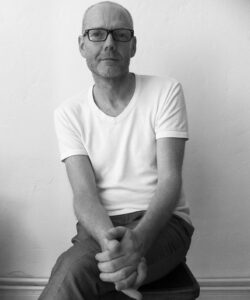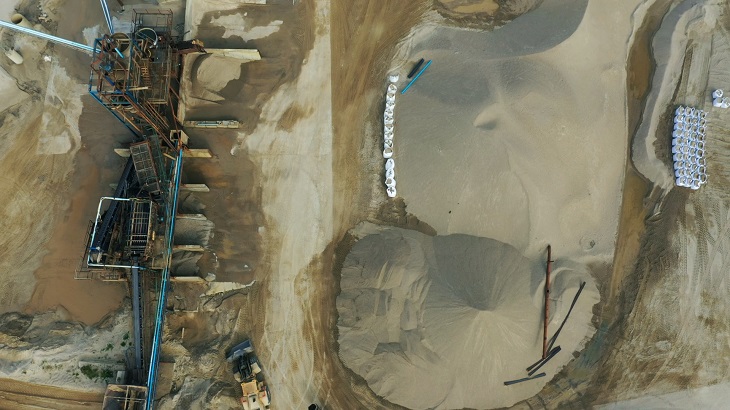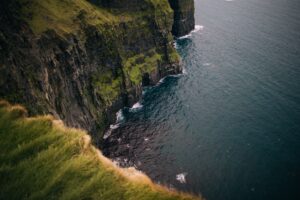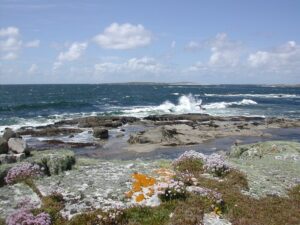Mark Clare, joint Earth Institute and Dun Laoghaire Rathdown County Council speaks about his plans for the residency, how he works as an artist, and participation, politics and punk.

Mark Clare
UCD Earth Institute & Dun Laoghaire Rathdown County Council Artist in Residence 2020-2021
Parity Studios profile
Tell us about how you started out as an artist
I went to art college when I was about nineteen, to Plymouth. I studied a BTech diploma in general art and design, which was like a two year foundation. From there I went to London to do Fine Art Sculpture at St Martins College of Art and Design. Then I took about ten years out before going to Belfast to do a Masters in Fine Art (MFA).
Were you practising as an artist all the time in between?
Yes. Straight from college.
What was St Martin’s like? Were you there in the 90s, was it very Britpop?
I left there in 1992. It was quite intimidating actually. It was all that, but of course you didn’t know we were in the middle of Britpop at the time. No-one told me! St Martins had different schools in different parts of town, they were just starting the amalgamation with Central, and that was the beginning of all those London schools amalgamating. It was exciting, it was fun.
Plymouth was a really unusual one because they had just started that course, and they were throwing money at it. As an eighteen or nineteen year old, I didn’t understand that that was strange. I made some of the biggest sculpture I’ve ever made in Plymouth, and then I went to London thinking that was the way college was, but it was more like, here’s some clay left over from twenty years ago.
There was this transition going on. When I was in sculpture most of the people were making three-dimensional objects. That movement into media was just starting. It might have been happening a bit more in Goldsmith’s but it hadn’t really hit our department. The opportunity to be cross disciplinary was there but we were working more within a sculptural tradition.
Mark Clare
Near Threatened
An Urgent Enquiry

How are you getting on so far with your residency at UCD/DLR?
I’ve been following a bunch of different threads.
There are two elements to my research at the moment. One has brought me very much down a rabbit hole. I’ve been talking to people about behavioural stuff, wanting to find out how to get people involved in the project. Obviously, I have this idea that there’s going to be this public outcome at the end. I’m having conversations with people about how you get people who aren’t interested in biodiversity to come. I mean, if I do workshops it’s very easy to fill them, that’s no issue, but you’re preaching to the converted. I’m trying to work out how I can broaden that, but Covid is making it much more difficult.
We have until next September so we can only hope, but it’s definitely more difficult. I was chatting to a couple of the other artists yesterday and we were saying we all feel slightly uncomfortable in the sense that I think it’s easier when you can go and knock on someone’s door rather than going and scheduling a zoom. You don’t really know what questions you want to ask, you’re just delving, and so you can feel like you’re taking and wasting people’s time.
I was talking to Bairbre Fox in the Science Centre, she said to go and sit over the West Wing, where they have the taxidermy section. To sit there at 11 and 1, to meet people. I didn’t know about it. It’s amazing. It’s like being in the Dead Zoo, all this taxidermied animals. There’s a giant Irish deer. It’s as good as the Natural History Museum.
The other element of my research relates to an unused plot of land opposite to where I grew-up. This piece of land was used for many years as a Pitch & Putt up until approximately 10 years or so ago. Growing up the story I heard was this piece of land had been bought by a group of local residents to stop it from being built on. After speaking to my 82yr old neighbour she informed me that in 1967 Roadstone Ltd bought the land with the intention of building a concrete factory on it. When the local women found this out they organised and picketed the entrance to the site and after some negotiation Roadstone donated the land to the residents stipulating that it was to be used for the benefit of the local community. In 1969 the local residents set up The Cabinteely Cultural and Educational Centre. The site was then turned into a Pitch & Putt for local residents but it was also used as the site for the first inauguration of the Cabinteely Boy Scouts and where they met for a period of time. I am currently exploring the possibility of re-activating this plot of land as a communal space with a biodiversity educational aspect to it. The Cabinteely Cultural and Biodiversity Educational Centre perhaps?
You’re doing lots of research, between talking to people and reading. Is that normally how you work? How do you balance research and the actual making of art?
That’s a really hard question to answer. That would be the way I work normally. Yet this feels much more intensive. I’ve started to think this, I’m not the science guy. I’m the guy who has a conversation with someone who says something to me and I’m like, that’s very interesting, and I go off with that and look at it and see what it is, I see how it relates to my tools and my medium, and I ask, where’s the visual element. It’s obviously trial and error. You’ll try something out and it just doesn’t work. You can really go at something full tilt and at the end of, it just doesn’t work. It ticks all the boxes but when you look at it – no.

Mark Clare – Inquiline (video still)
Is that just part of being an artist?
Totally. And there’s just no way of defining that. You know what’s good art, what’s bad art, I can’t define that, it’s going to be different for you than it is for me. Your interests may have nothing to do with my interests. How do you get that across in a project? How do you make something that is, particularly in this case, trying to engage with a large swathe of people?
The challenge to me is engaging with those people who wouldn’t normally engage with it. How do I advertise a workshop, where do I go to advertise that workshop to tap into those people? In Wexford I was tapping into Men’s Sheds a bit. That was interesting because the majority of the guys were very uncomfortable with the notion of art. But they were really interested in some of the things you’re talking about, and really interested in sharing their experiences.
Is it about getting over that threshold of people’s preconceptions?
Totally. There was two people who turned up to one workshop, I remember they were so uncomfortable for the first fifteen minutes, but then they got into it and afterwards they said that was great, and Billy would have loved that and Johnny would have loved this.
You bring a certain set of skills as an artist like conceptual framing, visual language, yet you’re treading with this project in a context where the people you’re talking to have very defined and specialist expertise. How do you negotiate that?
It’s a funny one. You feel like you’re the Jack of all trades, with no skills, particularly when you’re with people who’ve spent so many years focused. I mean I’ve spent twenty-five years focused on art but it meanders between mediums and interests.
What are the common threads over your career?
Since I did my MFA, I would say it’s political. It’s socially engaged, political. I see this project as political. Biodiversity, climate change, they are probably the most political things we are facing because it covers everything. So that’s how I came to. I didn’t come to it from a science background. I came to it in a political sense, and I had an interest in it. As a child, I had an interest in bugs and animals, stuff like that. Suddenly you find yourself back in a territory that you were interested in when younger. Even walking around in the West Wing of the Science building yesterday, I was like this is so cool.
This residency has a longer trajectory than many, what is that like?
It’s good and its bad, in the sense that again you’re going ah sure I’ve got time, I’ve got time. But then you’re three months in. The other side is that there’s so much on offer.
I’ve been talking to people about research, researchers, students working with DLR or who have worked with DLR, reading their reports which were incredibly technical, then sifting through them to try and have conversations, some are better than others at doing that. Then yesterday I met with a lady called Lorraine O’Hara who’s the park supervisor in DLR, and had a walk around Cabinteely park, talking about what they’re doing. There’s a practicality within what they have to do. There’s policy and politics involved but also it’s about how do we do this now, what’s going to work.
The UCD artist in residence schemes and Parity studios seem to be going from strength to strength
Yes. Emer’s incredible as well, with her experience at guiding us. It’s her who’s saying you know after three months you’d want to be getting something started otherwise you can just go into a black hole. This woman really knows what she’s talking about.
How do you manage the tension between being political and overly didactic?
That’s something I’m very aware of and I’ve become more aware of over the years. This is the thing. For me I would say art is like any other industry or trade, you’re learning your trade as you go. You know, you go to college and they give you a schooling in this that and the other, and you leave and you work within those parameters and then you start to find who you are and what you want to do. And obviously I think with anyone’s art practice I think it changes over time.
Subtlety can be powerful yet some people prefer a more direct approach
Yeah, and I would have been that guy ten years ago. It changes, your interests change, you change as a person. I guess the things I’m really interested in with art is the potential to produce a project that can be presented in various forms. You know, you can make a book, you can have a gallery exhibition, you can have a public outcome, and they’re all still on the same page and the same conversation but they’re tapping into different audiences and utilising different mediums and materials to kind of get that conversation out there.
Art seems similar to research training in a way, that you’re instructed formally to a point but your understanding develops more independently as a practice?
Yes. I mean I have friends who are painters and they fascinate me, in that they are totally focussed on a medium. Obviously there’s other things going on there, but a the end of the day it’s all about that medium. I have a difficult… well, I can dismiss it very quickly but when you stand in front of a painting that really hits you, it’s amazing. I’m also very interested in their ability to stick with that one medium. For me, I need to be kept interested. Maybe I’ve only got a 5 second memory – maybe I’m the goldfish.
Do you try to push yourself outside your comfort zone with techniques and media?
I certainly always would have tried to work with new mediums or learn something about a medium but then you do realise that you fall back on the language that you’ve developed over the years. Like I did a residency in Finland years ago. It was very interesting, as part of it they asked me to do a movie night, and I was thinking in relation to what I was doing, what could I show. I ended up getting a video by Crass, the punk band, I was into Crass when I was like fifteen. So I put it on twenty years later and I was sitting there going, oh my god that’s where I got my aesthetic. That’s where I learned my aesthetic.
Is that a nice feeling of continuity, a thread back through time?
Listen, Crass packed a punch then, they pack a punch now. It’s hardcore. Then you’re thinking, it triggered my interest. I was looking into it. They’re still living that lifestyle.
Finally, I’ve heard you use the term The Unavoidable Interconnectedness of Everything about recent work and projects. Tell us about that
The Unavoidable Interconnectedness of Everything is an umbrella title I am using for my current research. That title actually came out of a Timothy Morton book. For me it is a great way of saying what I’m trying to do. It has a Buddhist aspect to it, that’s what it is I, trying to make people aware that everything is interconnected, because that seems to be the only way to possibly sway people’s thinking. Everything has a history, obviously someone who is born now has no understanding of twenty years ago, and making that apparent is a really powerful thing.



